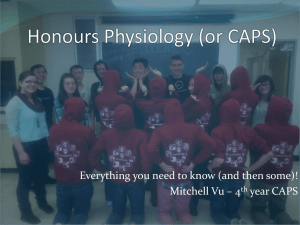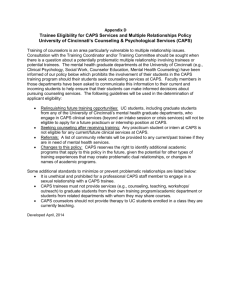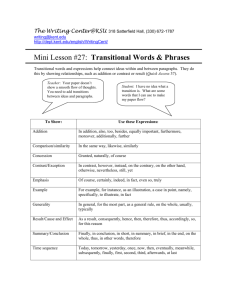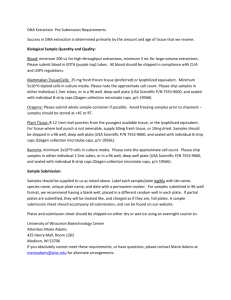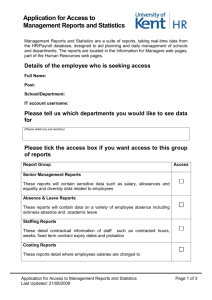caps-triennial-rep-08 - Centre for Astrophysics and Planetary
advertisement
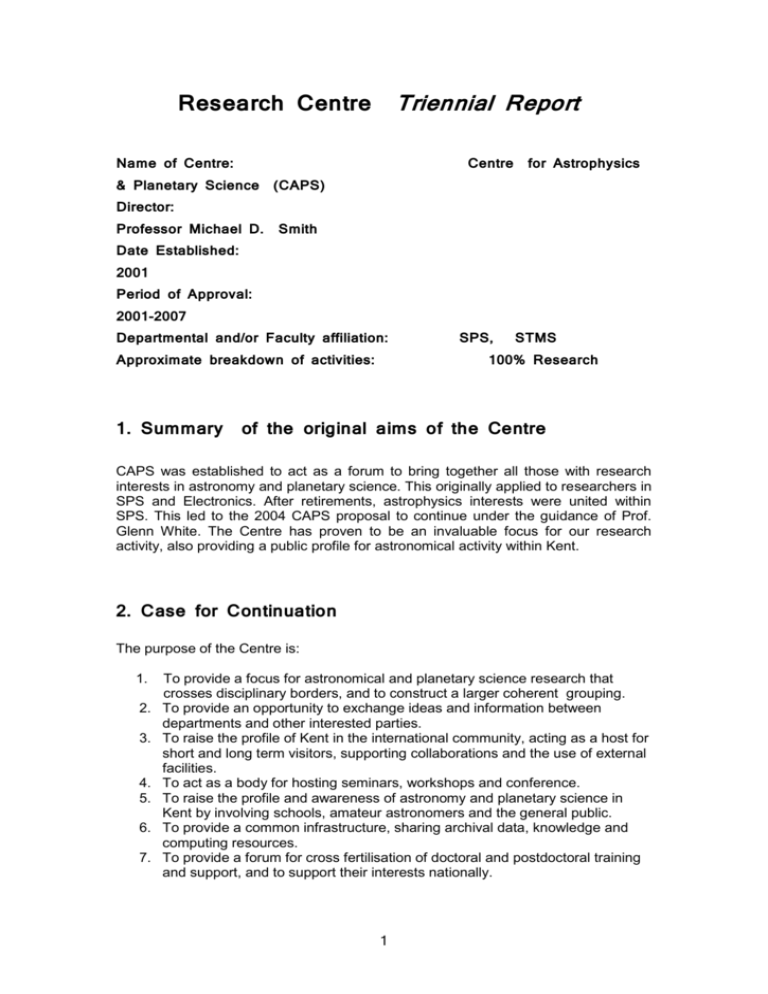
Triennial Report Research Centre Name of Centre: Centre for Astrophysics & Planetary Science (CAPS) Director: Professor Michael D. Date Established: Smith 2001 Period of Approval: 2001-2007 Departmental and/or Faculty affiliation: Approximate breakdown of activities: SPS, STMS 100% Research 1. Summary of the original aims of the Centre CAPS was established to act as a forum to bring together all those with research interests in astronomy and planetary science. This originally applied to researchers in SPS and Electronics. After retirements, astrophysics interests were united within SPS. This led to the 2004 CAPS proposal to continue under the guidance of Prof. Glenn White. The Centre has proven to be an invaluable focus for our research activity, also providing a public profile for astronomical activity within Kent. 2. Case for Continuation The purpose of the Centre is: 1. 2. 3. 4. 5. 6. 7. To provide a focus for astronomical and planetary science research that crosses disciplinary borders, and to construct a larger coherent grouping. To provide an opportunity to exchange ideas and information between departments and other interested parties. To raise the profile of Kent in the international community, acting as a host for short and long term visitors, supporting collaborations and the use of external facilities. To act as a body for hosting seminars, workshops and conference. To raise the profile and awareness of astronomy and planetary science in Kent by involving schools, amateur astronomers and the general public. To provide a common infrastructure, sharing archival data, knowledge and computing resources. To provide a forum for cross fertilisation of doctoral and postdoctoral training and support, and to support their interests nationally. 1 8. To provide a local host for Astronomy in the South-East of England through the SEPNet-Astro Community (see below). The change in the nature of astronomy and solar system research has accelerated in the last decade. It has moved into large scale international collaborations. Studies often require not only multi-wavelength experience but also cross-disciplinary experience. Indeed, astronomy and space science are a combination of disciplines bringing together a mixture of natural sciences, computing, engineering and observation. For a full range of CAPS activities see: http://astro.kent.ac.uk . Major facilities in astronomy are located at high altitude or in space rather than at individual universities. The Centre employs many of these facilities and acts as a means to share user experience, campaign planning and data analysis. CAPS has also changed in the last four year with two faculty leaving and being replaced. This led to a lull in activity during 2004 and 2005. However, CAPS is now much more productive than ever. The number of refereed journal publications has reached a very high level, staff associated with CAPS is also increasing, and grant income has started to increase. CAPS now provides a focus for many international collaborations as evidenced by world maps on our STARLINK project websites and collaboration pages (see http://astro.kent.ac.uk/research/collaborators.html ). Furthermore, it provides an interface which encourages the participation of all those interested in progress in astronomy and planetary science within Kent. We are thus developing several new programme teams in order to organise our activities. The Centre’s research programme includes experiment, observation and simulation under a variety of fields from astrobiology and astrochemistry, on to astrophysics. Observation campaigns are being executed at major gound-based and space-based facilities. New impetus is to be injected into Radio Astronomy in the coming years. Planetary science is to forge ahead with new ESA and NASA support. It is thus crucial to organise these diverse activities into a synergistic entity, as encapsulated by the CAPS Strategic Plan (http://astro.kent.ac.uk/mds/CAPS/ ). Holding seminars, bringing in visitors, and maintaining an identity as a small astronomy enterprise among enormous UK institutes, is enabled by the Centre’s identity. CAPS unites astronomical activity inside the University and around Kent. It focusses us as providers to outsiders, gives us an identity in a competitive world and emphasizes our status as highly productive researchers. The established CAPS reputation promotes collaborations with larger institutes. As part of SEPNET, it will also help us share resources with other astronomy groups. As part of the UNESCO/IAU International Year of Astronomy we will be coordinating local activities. We therefore request that the Review recommend that the Centre is continued. 3. Current Staff & Resources Current Faculty: Prof Mark Burchell, Dr Dirk Froebrich, Dr Jingqi Miao, Prof Michael Smith. Research staff: Dr Michael Cole (Exp. Officer), Dr Mark Price 2 Associate Research Staff: Dr. Alex Rosen (Bonn), Dr Anthony Moraghan (Dublin), Dr Duncan McKay (Simon Langton, Canterbury), Stephen Hamer (Durham), Christopher Rees (Magnox Electric) Observatory Team: Dr John Kemp, Dr Kaz Krynicki Space School ScienceTeam: Dr. Jo Mann (Rocket Scientist), Dr Robert Gore (Rocket scientist), Dr David Wilson, Dr Vicki Fitzgerald, Anika Walls- Bruck, Elizabeth Mannering (Univ. Bristol), Gregory Williams + SPS student volunteers Space School Coordinators: Steve Walls (SPS), Sharon Humm (SPS) Computational Astrophysics Team: Dr Alex Freitas (Computing Lab, UKC), Nicolas Miles, Michael Knight, Rick Walker Students: 7 PhD, 2 MSc Hardware Resources: Computing. The research resources for astronomy are generated from externally funded grants and contracts. The research activity takes place within SPS with a STFC provided Starlink computer cluster that is used for astronomical data reduction by all CAPS researchers. Simulations. At present, a suitable cluster for numerical astrophysics is not available on site. Simulations have still been performed through infrastructure provided by other institutes within international collaborations and on local PCs. Telescopes. Outreach activity takes place at the Observatory on the campus site. The newly-formed Observatory team have been active in the academic year in procuring, constructing and renovating instruments (funded by CAPS). Experimental Resources: Two Stage Light Gas Gun Aerogel Manufacturing Unit Raman Spectroscopy Suite Software Resources: CAPS maintains research archives which are consulted and used by researchers internationally: The Protostellar Mine & Jets Simulations. External Resources/Facilities: present staff as Principle Investigators UKIRT (United Kingdom Infrared Telescope); JCMT (James Clerk Maxwell Telescope); VLT (ESO Very Large Telescope); NTT (ESO New Technology Telescope); SALT (South Africa Large Telescope); Gemini North (8 metre telescope); INT (Isaac Newton Telescope); Forge Supercomputer, Armagh Observator (until 2005); UKAFF, United Kingdom Astrophysical Fluid Facility. External Resources used as Co-Investigators (further to PI list). 3 Spitzer Space Telescope; USA: NASA Stardust Mission Data Herschel Space Telescope (approved mission programme); VLTI-AMBER: Very Large Telescope Interferometer; USA: Kitt Peak National Observatory (4-metre telescope); USA:MMT Multiple Mirror Telescope, Arizona (6.5 metre telescope); Russian SAO Special Astrophysical Observatory (6 metre telescope); Chinese National Astronomical Observatory; Armenian Byurakan Observatory Japanese Subaru Infrared Observatory; Irish: CosmoGrid Recent/Present Financial Resources: Grants & Enterprise INTAS Open Call 2003, 03-51-4838 The causes and effects of protostellar outflows e101,560 01/04/04 – 31/10/07, PI = Prof. M.D. Smith PPARC/E509914/1: Summer Space School at Kent, £4,000, 01/05/07 - 30/04/2009, PI = Dr. J. Miao PPARC/E001823/1: Visitor Support Grant for Theoretical Astrophysics at the University of Kent, £10,123, 01/10/07 - 30/09/10, PI = Prof. M.D. Smith PPARC/C000455/1: Starlink Manager Grant, £69,000 01/04/05 - 31/03/09, PI = Prof. M.D. Smith PP/D003083/1: PATT Rolling Grant for Travel, £30,691 14/09/2006 - 13/09/2008, PI = Prof. M.D. Smith STFC/F003153/1: Minor icy bodies and cosmic dust, £543,624 01/07/2008 - 30/06/2011, PI = Prof. M.J. Burchell FP7-PEOPLE-IRSES-2008/230843 Marie Curie International Research Staff Exchange Scheme, e43,000 (total) Awarded, dates TBA, PI = Dr. N. Kumar (Porto) Lockheed-Martin contracts: £15,000 + (in negotiation) £5,000 NASA sub-contract $12,500 PI = Prof. M.J. Burchell 4. Achievements of the Centre in past 3 years & the added value. A relatively large number of publications, seminars and progress reports provide quantitative evidence of CAPS success. CAPS publications since 2006 are collated and presented at: http://astro.kent.ac.uk/research/caps-papers.htm This shows the count of refereed publications as 27 (2006), 18 (2007), 20 (2008, Jan-August) for papers with authors affiliated as Kent CAPS members. A complete seminar list for 2007-2008 Astronomy & Space Science has been maintained (see webpage). 35 talks are listed, almost all CAPS organised, including several external speakers. In 2006, an international conference on Astrobiology was held on campus and, in 2008, two Royal Astronomical Society meetings in London were all organised by Prof. Burchell. 4 The ability of CAPS to organise and promote research activities is demonstrated in triannual reports to the SPS. All reports written by the present Director are available online at: http://astro.kent.ac.uk/mds/CAPS . Members have recently been organised into Teams with specific responsibilities. Strength is created by involvement of outside staff, in terms of visitors and local volunteers. This has greatly bolstered our Observatory and Space School support. The research programme has benefited from re-organisation. The research fields have been focussed away from extragalactic astronomy towards star formation, although cosmology, galactic structure and planetary nebula are active themes. Solar system science remains strong with a greater connection to star formation studies in the coming period. Among the observational achievements can be included the discovery of new globular clusters, the discovery of new outbursting stars called FU Orionis objects, discovery of brown dwarfs and the first interstellar detection of the molecular hydrogen line 8-6 O(4). Computational achievements include predictions for how young stars interact with their environment, how protostars evolve and how clouds evolve when illuminated by a nearby hot star. Expansion into the field of hydrocode simulations of solar system phenomena has also been achieved. Experimental achievements include laboratory simulations of the Smart-1 impact on the lunar surface, analysis of Stardust aluminium foils, Raman spectroscopy of Stardust sample returns and simulation of oceanic hypervelocity Impact events. CAPS has also undertaken educational events for schools and scout groups, held public talks in collaboration with the amateur society, SEKAS, the student society SpaceSoc, and the Kent Physics Centre. 5. Plans for the future continuation and development of the Centre Research structure To remain vibrant, research aims must continue to change. The CAPS concept allows us to unite our ideas on where our fields are going and discuss how to use these ideas to create a synergy. We have thus found a new role and new goals within UK astronomy, summarised in our Strategic Plan, available online at http://astro.kent.ac.uk/mds/CAPS/caps-strategy08.doc Astronomy in Kent has gone through a major upheaval. Instrument construction has disappeared and we now focus our new expertise into rapidly growing fields of astronomy within which we possess world leading talent. Our aim is to grow into a medium-sized group with high synergy and strong international collaboration. Space Science in Kent has had remarkable recent success in all aspects. This is now a prime area for further investment to build upon what is a jewel in Kent Science. CAPS is working with NASA (return to the Moon programme and missions to comets). 5 To maximise profit from these future collaborations, we will trying to acquire (a) high speed imaging equipment, (b) a new scanning electron microscope and (c) a new Raman spectrometer. This will align Kent with national trends to support Moon and Mars sample return missions (in support of ESA’s Aurora programme). The main astrophysical area of concentration will be Numerical Astrophysics. Astrophysics, astrobiology and space science require numerical simulations to understand the Physics of Complexity and to extrapolate to the extreme physical regimes of stellar environments. The need to explore the new paradigm of Impact Astrophysics (e.g. shock waves, turbulence, jets and explosions), to which CAPS members are leading exponents, requires the acquisition of a Compute Cluster. We will seek funding for a state-of-the-art Supercomputer. In the CAPS 2008 Strategic Plan, we express the need for the machine, the requirements and the superb value of the low-risk investment. Infrastructure and management are in place. We expect the investment to be recuperated through grant applications and fees. The initial request is for £50K for CAPS. However, £90K all inclusive would place a large fraction of the Kent Physics programme back onto an internationally competitive basis, and place us in a position to forge ahead and take advantage of the successful SEPNET bid. We see the Supercomputer as a precursor. Once established, we will endeavour to form a Physics Supercomputer Laboratory on a larger scale. This would be a major investment of about £1.2M supporting both interdisciplinary research within the University and Physics research in the South-East of England, aiding SEPNET research. LOFAR is the LOw Frequency ARray for radio astronomy. It is a project to build an array of radio telescopes distributed across the Netherlands, Germany, Great Britain and France, and possibly other European countries such as Poland, Sweden, Ireland and Ukraine, with a total effective collecting area of about one tenth of a square kilometre. The processing of the data is done by a Blue Gene supercomputer situated at the University of Groningen. CAPS has been given the opportunity to participate in LOFAR through a £50,000 fee provided by the SEPNet initiative. Kent astronomers are playing a leading role in the astrophysics theme, which aims to build research excellence centred on radio astronomy and data processing. The first UK station will be constructed at Chilbolton in Hampshire, a site which has long been employed by Kent radio astronomers. This will also lead to a strong collaboration between astronomers in Germany and the Netherlands. LOFAR is expected to be a precursor to the SKA, the square Kilometre Array, one of the most ambitious world projects now being planned. CAPS staff numbers are set to grow in the coming years. SEPNET support will expand our Star Formation activities into Radio Astronomy with the appointment of a new lecturer. The SEPNET-Astro Consortium includes Kent, Oxford, Portsmouth, QMUL, Southampton and Sussex.and we will be building strong research links with astronomers at these institutes. In addition, we will be seeking to hire a second Space Scientist lecturer to take full advantage of increasing opportunities in this area. SEPNET funding will also provide for Chilbolton improvements and computer facilities. Our observational programme will continue to exploit data from Sky Surveys, with specific research targets in galactic astronomy. This will be strongly tied to our 6 modelling and theory programme. New STFC standard grant applications have also been submitted this year. The year 2009 is International Year of Astronomy. At present, we are discussing our participation in the Dark Skies Inspiration programme. We aim to put on activities involving the Observatory, Public talks and the Space School. Management structure The CAPS management committee will oversee all aspects of research planning and activities. The Committee will include the Director, two representatives from the main research areas and a representative from the post-doctoral staff. The main responsibilities of the Committee are (1) to encourage innovative research, particularly interdisciplinary research, and so exploit the diverse skills within the Centre, (2) provide the environment for research students to thrive in, (3) monitor the training and progress of students and (4) coordinate and control the submission of research proposals. Information and news is extensively discussed at weekly CAPS meetings involving all CAPS members. 7
